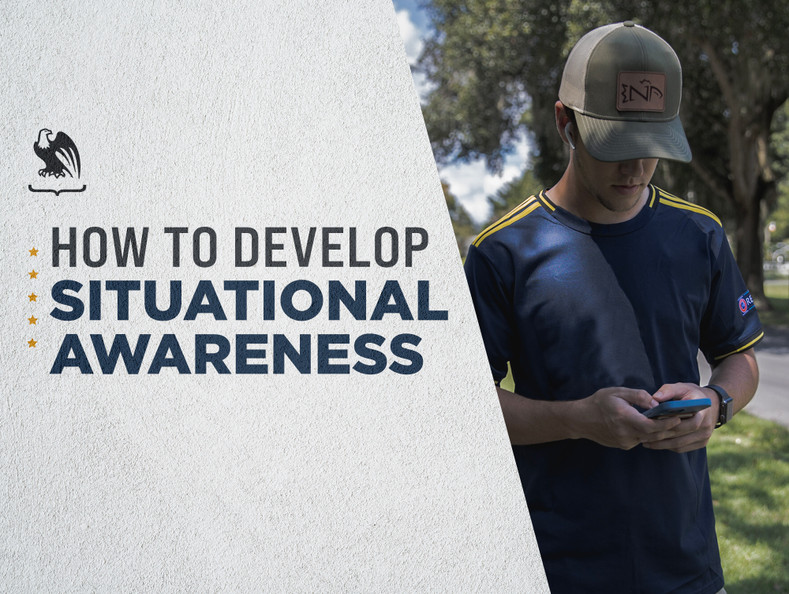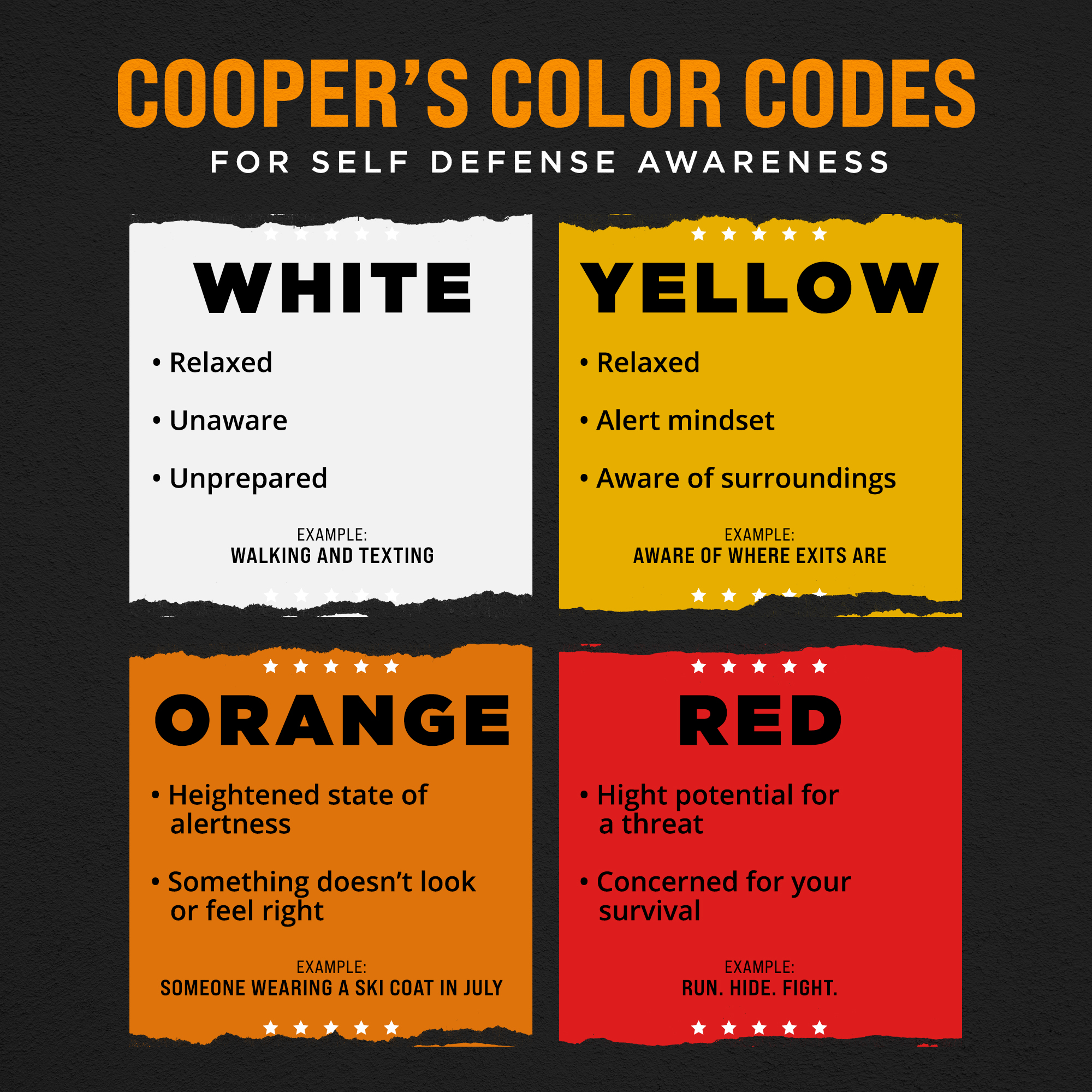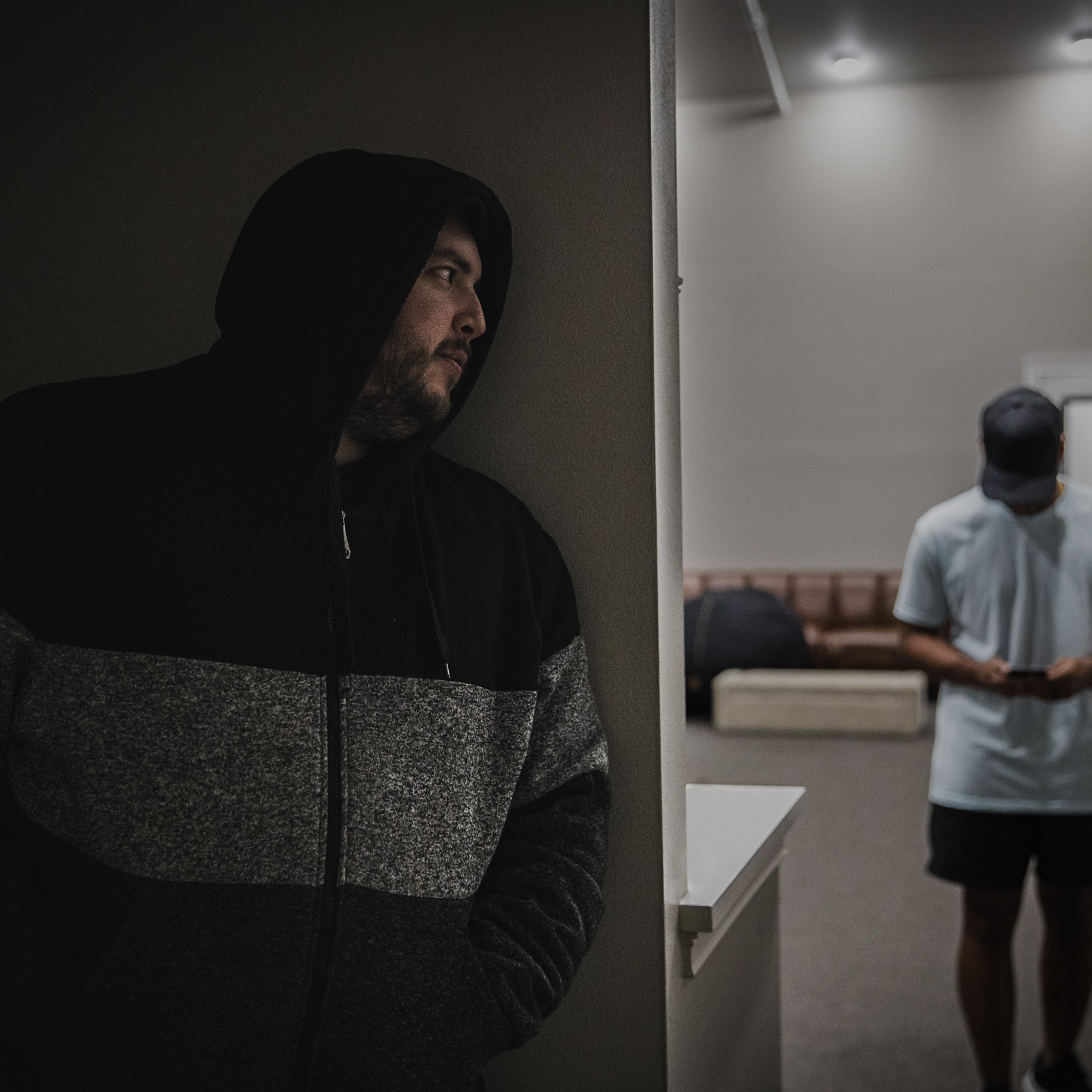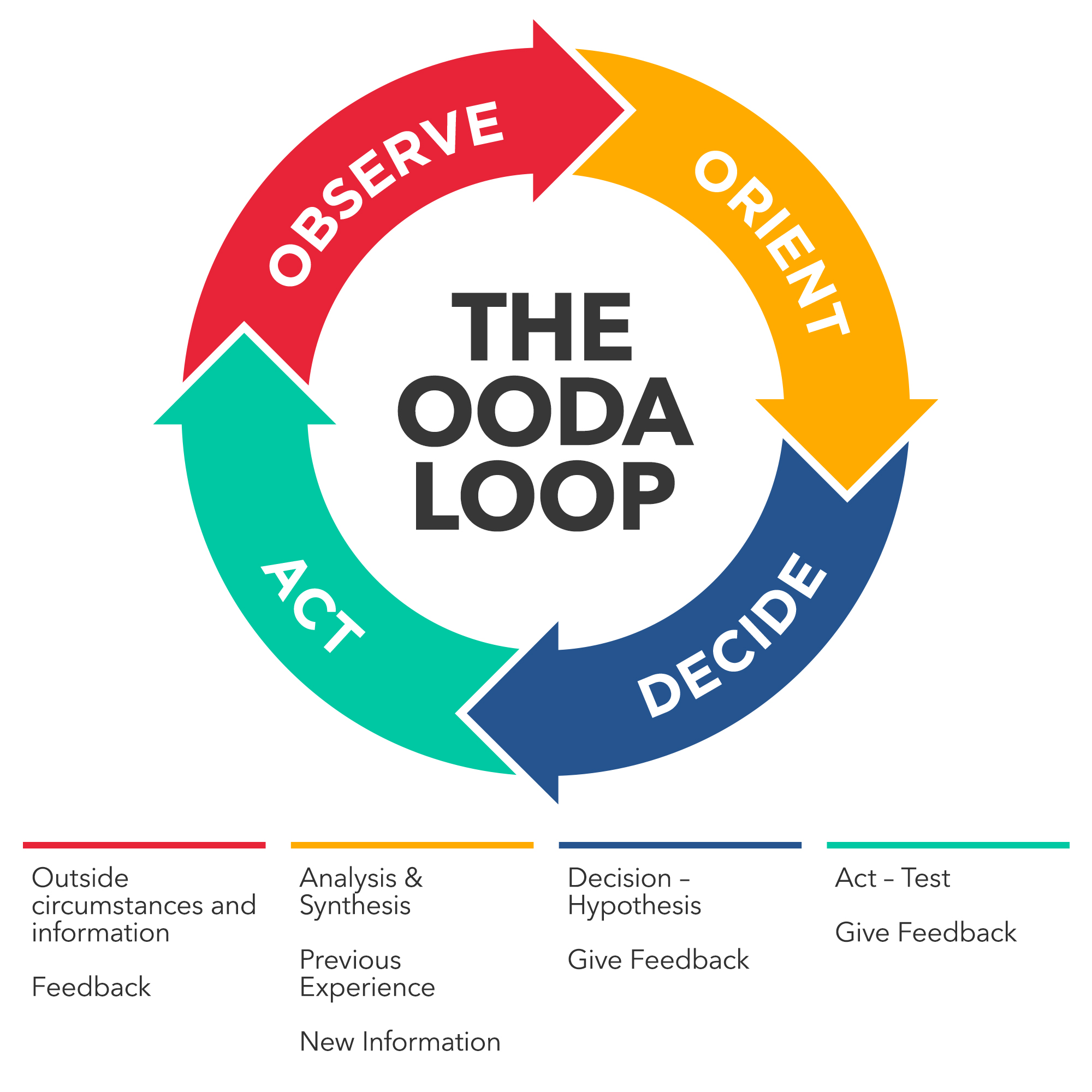How to Build Situational Awareness and Identify Threats

It’s not enough to carry a concealed weapon, take classes, and train often.
While all these things are great, and you should do them, equipment and training can only get you so far. If you’re not aware of your surroundings, by the time you realize you’re in danger, it could be too late.
That’s where the concept of “situational awareness” comes in. The idea is to be aware of your surroundings so you can assess any potential dangers and prepare to defend yourself or, ideally, avoid the situation in the first place.
So let’s get into why it’s important to be aware of your surroundings and discuss strategies for how to develop situational awareness.
What is Situational Awareness?
Situational awareness is all about paying attention to what’s going on around you. That means looking out for any person, thing, or situation that is potentially threatening, then avoiding it if possible and taking action to defend yourself if necessary.
While the actual term wasn’t coined until more modern times, situational awareness (SA) has been taught and practiced in the military for centuries. Today, the concept has been applied to everything from workplace safety to technology, though it is still most often used in the military, police, and self-defense communities.
The concept is often broken up into four situational awareness levels. First introduced by U.S. Marine Colonel Jeff Cooper in the 1970s, the “Cooper Color Code” indicates the different mental states of awareness, or “conditions,” that a person may be in at any given time.

There are 4 levels of situational awareness:
Condition White – Condition white is a state in which you are completely unaware of your surroundings. Whether distracted by something or simply oblivious to what’s happening around you, this condition leaves you unprepared and vulnerable to attack. Unless you are asleep or sitting in a bubble bath at home, you should never be in condition white.
An example of condition white would be walking down the street with your earbuds in while looking down at your phone. In that state, you have no way of noticing any sort of threat, whether that’s a car barreling toward you or a mugger sneaking up from behind. And when danger strikes, you’ll be caught off guard and slow to react.
Condition Yellow – In condition yellow, you’re relaxed but alert. It’s not a state of paranoia but rather casually observing what’s happening around you as you go about your day. That way, if something sketchy is going on, you’ll notice. This is the condition you want to be in at all times while in public.
So, instead of texting and listening to Bon Jovi while you walk down the street, in condition yellow, you are walking confidently with your head up so you can see and hear what’s going on around you.
Condition Orange – In condition orange, you’re on edge. You’ve noticed something that’s not quite right, and you’re hyper-aware of what’s around you. Your focus is on the potential danger, and you’re prepared to defend yourself if you need to.
For example, you’re walking through a parking garage when a shady character starts walking toward you with his hands in his coat pockets. He could be harmless, but something about the way he’s approaching you sets you on edge. You turn to face him, identify nearby exits, and mentally prepare to reach for your gun in case the situation goes south.
Condition Red – In condition red, there is no longer a question of whether you’re in danger. Something bad has happened, and you are now in “fight or flight” mode. The plan you devised while in condition orange is now officially in action.
Example: the man in the parking garage pulls a knife from his pocket and starts running toward you. You quickly draw your weapon and use your command voice to order him to STOP. Surprised and out-gunned, he retreats, and you place a call to 911. Because you were ready, you were able to react appropriately and defend yourself.
Bonus: Condition Black – While not part of Cooper’s original color code, “condition black” was recently added to the list and is considered the “fifth condition” by some. In condition black, things are not going well. In this state, you are overwhelmed by fear and fail to respond in the face of danger.
Let’s say the man in the parking garage does not stop despite your drawn weapon and commands to back off. Instead, he rushes you with his knife, catching you off guard. Panic sets in, and instead of taking action, you freeze.
It should go without saying, but condition black is a state that you never want to be in. That’s one of the many reasons why it’s so important to get proper training and practice regularly so that when faced with a life or death situation, you react almost automatically.
While the color code itself can’t protect you from danger, learning to recognize what state you’re in at any given time can help you practice situational awareness.
That way, the next time you’re walking down the street and realize you’ve been blissfully meandering in condition white, you can correct yourself and deliberately move into condition yellow until it becomes second nature.
Red Flags: What Should Raise Your Awareness Level?

You don’t want to live your life in a state of ignorant bliss, but you don’t want to be paranoid, either. That’s how accidents and misunderstandings happen. So, what sort of things are worth raising your awareness level from yellow to orange?
Behavioral Cues: The first thing that should get your attention is anyone who is behaving in a way that seems highly unusual. Whether they appear nervous, are pacing, acting jumpy or jittery, loitering, staring, or walking aggressively, watch out. They could be mad about their mother-in-law overstepping, nervously awaiting a job interview, or dealing with a medical condition of some sort. Or, they could be up to something.
If you see someone acting suspiciously, just pay attention. Watch for signs that their behavior is escalating, and be prepared to respond appropriately.
Odd Clothing: We’re not asking you to judge people’s clothing styles. Rather, we’re saying it’s important to look out for unusual things like bulges in clothing or articles that just don’t seem to fit.
For example, if you notice someone is wearing a jacket indoors or when it’s 100 degrees outside, that’s suspicious. While it may just be someone who is unusually cold-blooded, there’s a chance that person is trying to hide something.
The same goes for strange bulges in someone’s clothing. While it could be a cell phone, or they’re just happy to see you, it could also be a concealed knife or firearm. Perhaps that person is part of the CCW community like you, or maybe they’re up to no good. Either way, it can’t hurt to keep a casual eye on them.
Physical Cues: It’s impossible to know what’s going on in someone’s head, so you have to look for physical clues that they’re about to make a move.
Obviously, if someone is making aggressive gestures, rushing toward you, or displaying other threatening physical signs, get ready to protect yourself. But it’s also important to watch for more subtle cues.
If someone has you on edge, watching their hands is more important than almost anything else. Before they can draw a weapon or make a move to attack you, they have to move their hands.
If their hands aren’t visible, watching their shoulders is the next best thing. Before taking any sort of action, a person must draw their shoulders back, alerting you that they’re about to make a move.
Verbal Threats: This one should be obvious: if someone is verbally threatening you or someone else, be on guard. Even if the person is saying something that’s not blatantly threatening or offensive, but makes you uncomfortable, pay attention.
Whether someone is catcalling you, yelling at someone nearby, or animatedly talking to themselves, it’s a good reason to be on guard as you never know how it might escalate. They may not be dangerous, but you can’t ignore a verbal cue.
Anything That Makes You Uncomfortable: We can’t stress it enough: trust your gut! If something or someone is making you feel uncomfortable, even if you can’t put your finger on why, don’t ignore it. It doesn’t make you judgemental; it makes you cautious.
Your mind is able to pick up on subtle signs of danger, so if something is doing or saying something that makes you uncomfortable or scared, there’s probably a reason. If it turns out to be nothing, great! But it’s always better to be safe than sorry.
Responding Without Overreacting
We’ve already hinted at this throughout this article, but one of the most important aspects of self-defense and situational awareness is responding appropriately depending on the circumstances.
While it’s important to pay attention to your surroundings and be prepared to defend yourself, be careful not to become paranoid. Paranoia never leads to anything good and could make you suspicious of people who are actually harmless.
After all, the last thing you want to do is be the one threatening someone because you misunderstood their actions and assumed the worst. It wouldn’t be the first time someone thought another person was drawing a gun when they were only reaching for their phone. The consequences of overreacting can be tragic.

So, how do you protect yourself while giving people the benefit of the doubt?
Well, at the end of the day, situational awareness is all about preparedness. When you are aware of potential dangers, you can craft a plan in your head to either remove yourself from the situation or defend yourself if it comes to that.
The laws regarding self-defense and when it’s justified vary by state. For that reason, it’s critically important that you familiarize yourself with the laws regarding reasonable and deadly force where you live. This knowledge can and should factor into the response planning you do while in condition orange. Not only will this help ensure that innocent people don’t get hurt, but it can help keep you out of trouble with the law.
How to Develop Situational Awareness
Simply being aware of Cooper’s color code doesn’t actually help you in practice. It takes time and dedication to develop good SA skills.
When learning how to develop situational awareness, the first thing you need to do is be more mindful of the state of awareness you are in. Recognizing when you are in condition white, and then consciously moving to condition yellow, will train your mind to automatically go to that state over time.
Next, you have to learn to use all your senses. Simply observing the people and objects around you isn’t always enough. You need to be able to listen for potential threats – like fast-approaching footsteps. It’s also important to notice any strange smells, like smoke or other scents that seem out of place, which can help you identify danger before you even see it.
Oh, and that prickling feeling you get when your hair stands on end? Definitely pay attention to that. Your body can sense when you’re in danger. Listen to it.
Something that can be helpful when training to notice the environment with all your senses is to establish a baseline of what’s normal. Next time you’re at work, your favorite bar, or even the neighborhood grocery store, take a moment to really experience the sights, smells, and sounds. Once you’ve established what’s normal, it’ll be easier to pick up on things that are out of place.
To help further develop your situational awareness skills, you may want to engage in some observational exercises while you’re out and about. Consistently doing so will help you start to notice things you would have otherwise missed. We’ll go over some simple exercises to help you develop your skills next.
Finally, specific situational awareness training is an option that you may find helpful. You can find games and activities online to help you fine-tune your observation skills, or you can attend an SA training session in person with a firearms trainer.
Situational Awareness Exercises
With regular training, the following situational awareness exercises can help you go from condition white to condition yellow in no time:
Escape Routes: This is an easy exercise to do any time you walk into a new room. Next time you go to a new place, take a moment to identify every exit. This will help you build your observational skills and may come in handy if you need to leave quickly.
Take Attendance: Another easy way to build observational skills is to start counting the number of people in any given place. Whether you’re in a convenience store, a coffee shop, or a conference room meeting,take attendance of how many people are there.
You can also do this in parking lots. As you walk to your vehicle, look around you and notice how many people are sitting in their cars. Take note of other people walking in the parking lot and pay attention to which vehicles they are coming or going from.
People Watching: This one is kind of fun. Whenever you’re bored in public, look at the people around you and try to notice everything about them (without staring and creeping them out, obviously. You don’t want to send them into condition orange unnecessarily!).
Notice what people are wearing, how they look, what they have with them, and where they are heading. Based on your observations, try to make up a story about who you imagine they are. Where do they work? What is their personality like? What do you think they’re doing today?
Try to notice enough about them that you could give a detailed description to the police if you had to. Notice small details like whether they’re right- or left-handed, their eye color, any visible tattoos, and anything else that stands out or could be relevant.
On the Road: If you’re like most people, you tend to have the most time to yourself during your daily commute. Luckily, this is also an excellent opportunity to practice your situational awareness skills.
As you drive, keep an eye out for different driving behaviors and just take note. Try to notice which people are texting while stopped at a light, who is dancing to the radio, and how many people are in each car. It’s not only an easy way to become more observant, but it could help you prevent an accident!
Make Eye Contact: If you’re looking for an easy exercise that can be done anywhere, this is it. All you have to do is simply make eye contact with everyone you come across. Whether you’re driving, walking, or waiting in line at the store, make it a point to briefly make eye contact with everyone who comes your way. (Don’t stare, though, as it can come across as creepy or confrontational).
Not only is this a great way to start observing people, but it can also ward off potential attackers. Your body language tells a would-be criminal a lot about whether you’d be a good potential victim, and making eye contact not only shows confidence, which bad guys hate, but now that they know you’ve seen them, they’re less likely to attack.
Summary
It takes time to learn how to develop situational awareness. Simply knowing which color condition you are in and consciously choosing to be more observant can help you avoid potentially dangerous situations or defend yourself if you must.
Certain exercises, like identifying the exits in a building, counting the number of people around you, or otherwise “people watching,” can help you fine-tune your SA skills. Specific situational awareness training sessions are also an option for anyone looking to up their self-defense game.
If you’re looking for belts or holsters, we recommend visiting our Holsters by Gun Model page if you are looking for holsters that are custom-made for your weapon of choice. For all of our belt and holster options and for more information to help you choose the carry system that works best for you, visit our Vedder Holsters website.
Looking for items beyond holsters and belts, check out our Resources Page for popular product links like lights, lasers, first aid, maintenance, and more.

